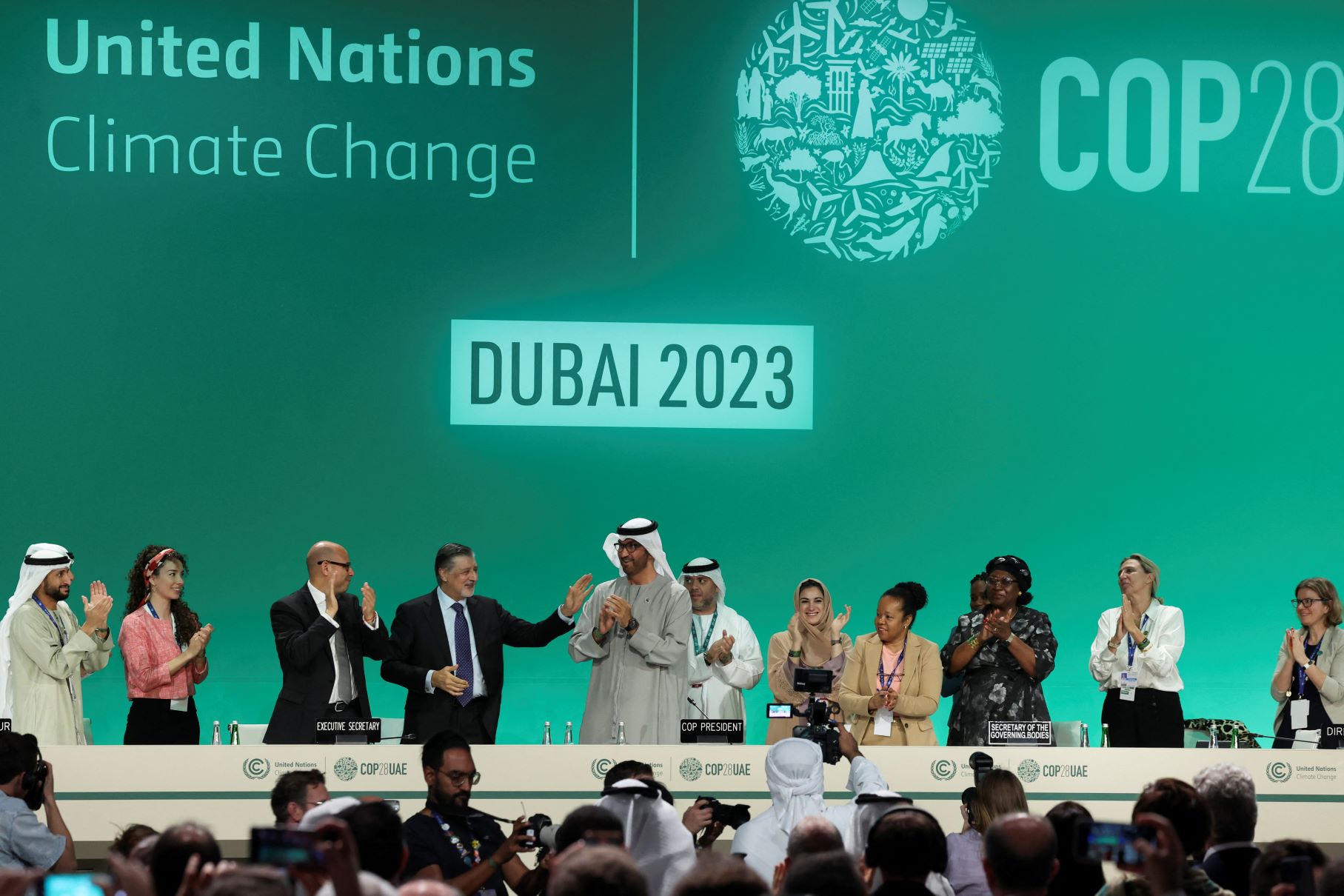More than 190 governments met in Dubai for the twenty-eighth Conference of the Parties (COP28) to the UN Framework Convention on Climate Change (UNFCCC) this month. Five CoC experts assess the UN climate summit as a set of mixed outcomes. They cite agreements that included loopholes, deferred decisions on difficult issues, and relatively low levels of funding pledges compared to what is needed to make progress as the planet continues to warm.

Hard-Won Compromise Yet Meaningful Steps Deferred
Despite facing geopolitical challenges, COP28 successfully completed the first Global Stocktake, which is a crucial mechanism for achieving the goals of the Paris Agreement. Under close scrutiny from media and observers, COP28 President Sultan Ahmed Al Jaber and his team delivered what they call a historic consensus that keeps the 1.5°C goal within reach. The UNFCCC decision, the first to mention all fossil fuels, is a major breakthrough, despite the many caveats in the text.
The process to arrive at the Global Stocktake decision was an uphill battle from the start and seemed on the verge of breaking down in Dubai. The most heated debate focused on the stocktake energy package; countries’ red lines are easy to identify in the final text. The consensus reached in the United Arab Emirates (UAE) signals a move away from fossil fuels in energy systems. It also provides clear references to the 1.5°C (2.7°F) goal and science-based action, including in nationally determined contributions (NDCs), which was far from a given. Still, weak language pervades the text, and it falls short of the significant step change needed to course correct that so many had advocated for.
Delegates also deferred a record number of agenda items to next year. Several crucial issues, including the global goal on adaptation, concluded with weak decisions that leave contentious questions—most notably how to finance adaptation efforts—to be solved at a later stage. The call to provide developing countries with the means needed to contribute to reaching increasingly ambitious climate targets will remain a central point of contention between industrialized countries and emerging economies. Who will pay the hundreds of billions of dollars for adaptation and unavoidable impacts remains equally unanswered. Despite the remarkable success of establishing and starting to fill the new Loss and Damage Fund, this issue persists.
Governments, particularly major emitters, need to develop more ambitious NDCs and update their long-term strategies. Most importantly, they need to design and implement domestic policies and instruments that align with a 1.5°C ambition. This should be done in a way that leverages competition in green technology markets to accelerate the transition while fostering international cooperation.
To make progress in the multilateral climate space, it is essential to address the valid concerns of less-advanced economies that could be left behind or hindered in their development aspirations. Addressing the issue of equity is also crucial to prevent further polarization and fragmentation, which would in turn also undermine efforts to stabilize the climate.
Progress on Many African Priorities, but Financing Is Cloudy
Prior to COP28, Africa’s climate priorities were clearly articulated in the Nairobi Declaration on Climate Change. Those priorities included accelerated global ambition to meet the Paris Agreement goals as part of the first Global Stocktake, progress on the Global Goal on Adaptation, and stronger commitments on climate finance needs, including the operationalization of the Loss and Damage Fund.
COP28 saw more than $700 million in initial pledges to the Loss and Damage Fund. The fact that developing countries were willing to pledge contributions to the fund and not block its progress deserves to be celebrated, but the funding remains a drop in the ocean. Cyclone Idai caused about $2 billion in loss and damage when it struck Mozambique in 2019, and estimates of loss and damage financing needs come to several hundred billion dollars a year.
In total, more than $85 billion was committed during COP28. More of this financing will go toward adaptation, which Africa and other developing regions have advocated for several years. Indeed, a key priority on Africa’s climate agenda was agreement on the adaptation targets for the Global Goal on Adaptation. The COP28 agreement calls for concrete planning and implementation of adaptation efforts by 2030, as well as significantly increased adaptation financing, yet the agreement does not include specific goals on adaptation finance.
The COP28 Global Stocktake process offered a critical opportunity for Africa to hold large emitters to account for climate action. The COP28 UAE Consensus was agreed to after lengthy deliberation and much global scrutiny over the presence of fossil fuel lobbyists at negotiations. It recognizes the need for deep, rapid, and sustained transitions away from fossil fuels. Energy poverty and equity still inform many Africans’ perspectives on energy transition. Home to 40 percent of the world’s renewable energy resources, Africa wants to use those valuable resources to catalyze strategic partnerships for an equitable global energy transition.
COP28 saw the loss and damage and energy transition imperatives on Africa’s agenda advance, but the true measure of success of COP28 for African concerns will be in the financial and practical implementation of the COP28 UAE Consensus. The active participation of some 85,000 people in COP28 reminds us of the spirit of shared determination to codesign sustainable climate solutions and partnerships to invest in building climate-resilient communities. While the outcomes of COP are often slow and unambitious, these multilateral processes are important for making incremental steps in the right direction.
Something for Everyone, but not Enough for the World
COP28 ended with a number of agreements that offered something for every group represented, but not enough for the world to avoid the harmful impacts of climate change.
For those concerned about climate justice, there were many pledges to increase financial assistance to vulnerable countries, including an agreement to operationalize the Loss and Damage Fund with pledges of up to $792 million. Though this is less than 1 percent of what is needed to support those facing the greatest climate-related harms, there was hope that opening the bank account means that it will receive adequate funds eventually. But the historic record on fund flows does not give much reason for optimism.
Led by the European Union, the global pledge on renewables and energy efficiency called for tripling renewable energy capacity to over 11,000 gigawatts and increasing the annual rate of energy efficiency gains to 4 percent by 2030. This was received with enthusiasm by the 130 countries that wanted a bigger role for renewable energy in decarbonizing the world. But China and India, two of the world’s top three emitters, were not among the signatories, and did not approve the phrasing that called for ending investments in unabated coal-fired power plants. While India and China lead the world in additional global renewables capacity—and will continue to invest in renewables without signing the pledge—they also build the most coal-based power plants. Of the 204 gigawatt coal-fired power plants under construction, about 67 percent are in China, and of the 353 gigawatt coal-fired power plants in planning, 72 percent are in China, with most of the rest in India.
The 13 percent annual average growth required to triple renewable energy capacity by 2030 will remain a challenge, as it is twice the growth rate achieved in the last five years. Efficiency improvements above 4 percent annually in the coming decade can reduce global energy consumption and emissions by a third, but will require more than tripling the rate of efficiency gains made in the last five years. The agreement to triple nuclear energy capacity by 2050 delighted the nuclear industry but shocked traditional environmentalists.
The call for transitioning away from fossil fuels in the first Global Stocktake agreement was approved by proponents of phasing down fossil fuels in the final agreement. But to the comfort of oil and gas producers and consumers, which includes most of the world, the text of the agreement is vague and not time-bound, and fossil fuel production and use can continue on a business-as-usual path. Some experts were disappointed over the gap between the rhetoric and reality of COP28 outcomes. Some blame it on the COP28 presidency residing with a large oil exporter, but the COP28 outcomes are no different from COP agreements from Kyoto in 1997 to Glasgow in 2021, where pledges were made if only to be broken.
Amid Achievements, Unmet Ambitions and a Push for Stronger Actions
COP28 produced important outcomes. While some items on the agenda did not see final decisions, promising progress was made on climate justice, energy transition, agricultural resilience, food security, and a wide range of other sectors closely associated with the 1.5°C target set in the Paris Agreement.
A significant accomplishment was the surge in climate finance pledges, which signal an overall global commitment. The Loss and Damage Fund launched at COP27 in Egypt became operational on the opening day of COP28. This historic agreement is based on the recommendations formed through five transitional meetings over the past year and the consensus among developed, polluting nations on supporting vulnerable communities to tackle the climate crisis and natural disasters. Immediately after the decision, countries including France, Germany, Italy, and the United Arab Emirates pledged more than $400 million to the fund. In contrast, the United States received criticism for its small contribution of $17.5 million. In total, more than $790 million was pledged to the fund by the time COP28 concluded.
COP28 was also marked by fierce debates that ultimately yielded calls for fossil fuel reductions in the first Global Stocktake. Despite its laudable achievements, many stakeholders consider the overall progress at COP28, especially in terms of eliminating fossil fuels, insufficient and unambitious. By assessing the pledges on renewable energy, energy efficiency, and methane made at COP28, the International Energy Agency concluded that the pledges so far will not keep the world on a trajectory within a 1.5°C temperature rise.
While a radical phase-out of fossil fuels remained missing in the final text, the stocktake explicitly highlighted the urgency of transitioning away from them and outlines multidimensional efforts that states should take. UN Climate Change Executive Secretary Simon Stiell characterized the decision as “the beginning of the end.” While the international consensus to shift away from fossil fuels has therefore crystallized, how major fossil fuel exporters, including the Gulf countries, will deal with the flexibility and how their pledges at and before COP28 will be implemented will be critical in the global climate action progress.
The negotiations might have come to an end, but countries and stakeholders advocating for a radical transition in the energy system will certainly continue to keep a closer eye on the next steps taken by oil producers.











